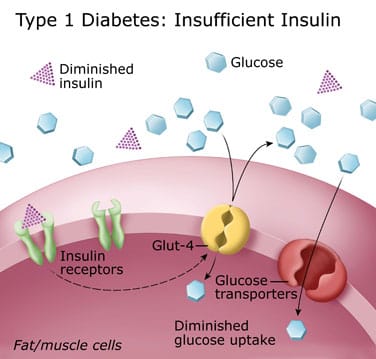Describe the Pathophysiology of Type 1 Diabetes Mellitus
A genetic predisposition and exposure to a virus are factors that may contribute to the pathogenesis of immune related. For effective understanding medicine has had pathophysiology of Type 1 Diabetes mellitus made easy by grouping into three categoriesThey are an autoimmune mechanism genetic considerations environmental factors.

Pathophysiology Of Type 1 And Type 2 Diabetes Mellitus Which Leads To Download Scientific Diagram
Continuing Education Activity.

. Insulin is a hormone needed to allow sugar glucose to enter cells to produce energy. Insulin production diminishes when beta-cell mass falls until the available insulin is no longer sufficient to maintain normal blood glucose levels. The pathophysiology of Type 1 diabetes mellitus suggests that it is an autoimmune disease wherein the bodys own immune system generates secretion of substances that attack the beta cells of the pancreas.
Consequently the pancreas secretes little or no insulin. Type I diabetes mellitus DM is insulin-dependent IDDM. Type 1 diabetes is the result of lymphocytic infiltration and destruction of insulin-secreting beta cells in the pancreas islets of Langerhans.
Type 1 diabetes is fundamentally caused by the autoimmune destruction of these insulin-producing cells. Type 1 diabetes is more common among children and young adults around 20 years. Type 1 diabetes mellitus.
Type 1 Diabetes Mellitus is a syndrome characterized by hyperglycemia and insulin deficiency resulting from the loss of beta cells in pancreatic islets Mapes Faulds 2014. Type 1 diabetes is due to pancreatic islet B cell destruction predominantly by an autoimmune process and these persons are prone to ketoacidosis. The following article reviews the basic pathophysiology of both type 1 diabetes mellitus and type 2 diabetes mellitus as we understand it today.
Type 1 diabetes once known as juvenile diabetes or insulin-dependent diabetes is a chronic condition in which the pancreas produces little or no insulin. Produce insulin moves glucose into cells inhibits breakdown of stored fats moves amino acid into cells for protein synthesis. Type 1 diabetes mellitus T1DM is an autoimmune disease that leads to the destruction of insulin-producing pancreatic beta cells.
Part B - Questions 1 Describe the pathophysiology of Type 1 Diabetes Mellitus. This is the result leads to total absence of insulin production. In type 1 diabetes the pancreas is unable to produce insulin.
Nonimmune type 1B diabetes occurs secondary to other diseases and is much less common than autoimmune type 1A. Pathophysiology of Type 1 Diabetes condition is by large characterized by a deficiency of insulin hormone. The pancreas is an organ below and behind the stomach that produces the hormone insulin.
Let Us Help Manage Living With Diabates. The destruction of beta cells in Type 1A. Ad With The Right Tools You Can Do Anything.
Insulin moves glucose into the cells to be stored and used for energy. Produce glucagon increase blood glucose lvls. Produce somatostatin inhibits prod.
Describe the acute complications of diabetes mellitus with a focus on differential detection and treatment. It continues on to reveal the things that go wrong when there is too much or too little glucose available. After antigen presenting cells APCs present beta-cell antigens to the immune system chronic immunological responses occur due to inefficient regulation of immunological reactions which.
Importantly insulin allows glucose to enter muscle and adipose. Its main clinical characteristic is hyperglycaemia. Describe the pathophysiology of Type 1 Diabetes Mellitus.
More patho of type 1 diabetes. Type 1 diabetes is an immune mediated disease caused by autoimmune destruction of the pancreatic B cells the site of insulin production. Etiology and pathophysiology of type 1 and type 2 diabetes mellitus.
This article will focus on the cause clinical features and implications of type 1 diabetes. Diabetes mellitus is a complex metabolic disorder associated with an increased risk of microvascular and macrovascular disease. Different factors including genetics and some viruses may contribute to type 1 diabetes.
Type 1 diabetes is diabetes caused by the immune system attacking and destroying the cells in the pancreas that produce insulin. These antibodies are used to differentiate type I DM from type II non-insulin-dependent DM. Type 1 diabetes occurs as a result of the bodys immune system attacking the insulin producing beta cells of the pancreas although it is not clear why.
The last century has been characterised by remarkable advances in our understanding of the mechanisms leading to hyperglycaemia. Insulin is normally synthesised in the pancreas by the b-cells of the islets of Langerhans in response to a glucose stimulus. Type 1 diabetes mellitus results from a cellular-mediated autoimmune destruction of the insulin-secreting cells of pancreatic ß-cells.
While type 2 diabetes is the more prevalent form and results from insulin resistance with a. The autoimmune process begins many years before clinical detection and presentation. The Path To Understanding Diabetes Starts Here.
Type 1 diabetes is an autoimmune condition that activates the immune system to destroy the insulin- producing cells in the pancreasThe pancreas a big gland behind the stomach stops producing insulin in type 1 diabetes because the immune system of the body has demolished the cells that create. Insulin is an essential anabolic hormone that exerts multiple effects on glucose lipid protein and mineral metabolism as well as growth. Diabetes Mellitus Type 1 Pathophysiology.
Type 1 diabetes mellitus pathophysiology T1DM develops through elicitation of the immune system against beta-cell antigens and initiation of proinflammatory responses. It is becoming increasingly recognized that this disease is an organ-specific form of autoimmune disease that results in destruction of the pancreatic islet cells and their products. Type 1 Diabetes Mellitus Pathophysiology.

Pathophysiology Of Diabetes Mellitus

Pathophysiology And Clinical Presentation Type 1 Diabetes Mellitus

A Schematic Diagram For Pathogenesis Of Type 1 Diabetes Mellitus Download Scientific Diagram
No comments for "Describe the Pathophysiology of Type 1 Diabetes Mellitus"
Post a Comment